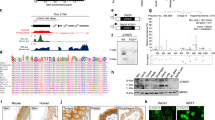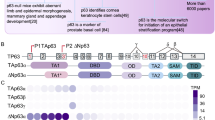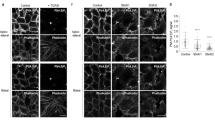Abstract
Changes in cell adhesion and polarity are closely associated with epithelial cell transformation and metastatic capacity. The tumor suppressor protein ASPP (Apoptosis-Stimulating Proteins of p53) 2 has been implicated in control of cell adhesion and polarity through its effect on the PAR complex. Here we demonstrate that under hypoxic conditions, the ubiquitin ligase Siah (seven in absentia homolog)2 controls ASPP2 availability, with concomitant effect on epithelial cell polarity. LC-MS/MS analysis identified ASPP2 and ASPP1 as Siah2-interacting proteins. Biochemical analysis confirmed this interaction and mapped degron motifs within ASPP2, which are required for Siah2-mediated ubiquitination and proteasomal-dependent degradation. Inhibition of Siah2 expression increases ASPP2 levels and enhances ASPP2-dependent maintenance of tight junction (TJ) integrity, and polarized architecture in three dimensional (3D) organotypic culture. Conversely, increase of Siah2 expression under hypoxia decreases ASPP2 levels and the formation of apical polarity in 3D culture. In all, our studies demonstrate the role of Siah2 in regulation of TJ integrity and cell polarity under hypoxia, through its regulation of ASPP2 stability.
This is a preview of subscription content, access via your institution
Access options
Subscribe to this journal
Receive 50 print issues and online access
$259.00 per year
only $5.18 per issue
Buy this article
- Purchase on Springer Link
- Instant access to full article PDF
Prices may be subject to local taxes which are calculated during checkout




Similar content being viewed by others
References
House CM, Moller A, Bowtell DD . Siah proteins: novel drug targets in the Ras and hypoxia pathways. Cancer Res 2009; 69: 8835–8838.
Nakayama K, Frew IJ, Hagensen M, Skals M, Habelhah H, Bhoumik A et al. Siah2 regulates stability of prolyl-hydroxylases, controls HIF1alpha abundance, and modulates physiological responses to hypoxia. Cell 2004; 117: 941–952.
Calzado MA, de la Vega L, Munoz E, Schmitz ML . Autoregulatory control of the p53 response by Siah-1L-mediated HIPK2 degradation. Biol Chem 2009; 390: 1079–1083.
Kim H, Scimia MC, Wilkinson D, Trelles RD, Wood MR, Bowtell D et al. Fine-tuning of Drp1/Fis1 availability by AKAP121/Siah2 regulates mitochondrial adaptation to hypoxia. Mol Cell 2011; 44: 532–544.
Li S, Li Y, Carthew RW, Lai ZC . Photoreceptor cell differentiation requires regulated proteolysis of the transcriptional repressor Tramtrack. Cell 1997; 90: 469–478.
Schmidt RL, Park CH, Ahmed AU, Gundelach JH, Reed NR, Cheng S et al. Inhibition of RAS-mediated transformation and tumorigenesis by targeting the downstream E3 ubiquitin ligase seven in absentia homologue. Cancer Res 2007; 67: 11798–11810.
Ahmed AU, Schmidt RL, Park CH, Reed NR, Hesse SE, Thomas CF et al. Effect of disrupting seven-in-absentia homolog 2 function on lung cancer cell growth. J Natl Cancer Inst 2008; 100: 1606–1629.
Qi J, Nakayama K, Gaitonde S, Goydos JS, Krajewski S, Eroshkin A et al. The ubiquitin ligase Siah2 regulates tumorigenesis and metastasis by HIF-dependent and -independent pathways. Proc Natl Acad Sci USA 2008; 105: 16713–16718.
Qi J, Nakayama K, Cardiff RD, Borowsky AD, Kaul K, Williams R et al. Siah2-dependent concerted activity of HIF and FoxA2 regulates formation of neuroendocrine phenotype and neuroendocrine prostate tumors. Cancer Cell 2010; 18: 23–38.
Samuels-Lev Y, O'Connor DJ, Bergamaschi D, Trigiante G, Hsieh JK, Zhong S et al. ASPP proteins specifically stimulate the apoptotic function of p53. Mol Cell 2001; 8: 781–794.
Vives V, Su J, Zhong S, Ratnayaka I, Slee E, Goldin R et al. ASPP2 is a haploinsufficient tumor suppressor that cooperates with p53 to suppress tumor growth. Genes Dev 2006; 20: 1262–1267.
Kampa KM, Acoba JD, Chen D, Gay J, Lee H, Beemer K et al. Apoptosis-stimulating protein of p53 (ASPP2) heterozygous mice are tumor-prone and have attenuated cellular damage-response thresholds. Proc Natl Acad Sci USA 2009; 106: 4390–4395.
Langton PF, Colombani J, Chan EH, Wepf A, Gstaiger M, Tapon N . The dASPP-dRASSF8 complex regulates cell-cell adhesion during Drosophila retinal morphogenesis. Curr Biol 2009; 19: 1969–1978.
Cong W, Hirose T, Harita Y, Yamashita A, Mizuno K, Hirano H et al. ASPP2 regulates epithelial cell polarity through the PAR complex. Curr Biol 2010; 20: 1408–1414.
Sottocornola R, Royer C, Vives V, Tordella L, Zhong S, Wang Y et al. ASPP2 binds Par-3 and controls the polarity and proliferation of neural progenitors during CNS development. Dev Cell 2010; 19: 126–137.
Chen D, Padiernos E, Ding F, Lossos IS, Lopez CD . Apoptosis-stimulating protein of p53-2 (ASPP2/53BP2L) is an E2F target gene. Cell Death Differ 2005; 12: 358–368.
Fogal V, Kartasheva NN, Trigiante G, Llanos S, Yap D, Vousden KH et al. ASPP1 and ASPP2 are new transcriptional targets of E2F. Cell Death Differ 2005; 12: 369–376.
Liu ZJ, Lu X, Zhang Y, Zhong S, Gu SZ, Zhang XB et al. Downregulated mRNA expression of ASPP and the hypermethylation of the 5'-untranslated region in cancer cell lines retaining wild-type p53. FEBS Lett 2005; 579: 1587–1590.
Zhu Z, Ramos J, Kampa K, Adimoolam S, Sirisawad M, Yu Z et al. Control of ASPP2/(53BP2L) protein levels by proteasomal degradation modulates p53 apoptotic function. J Biol Chem 2005; 280: 34473–34480.
Habelhah H, Laine A, Erdjument-Bromage H, Tempst P, Gershwin ME, Bowtell DD et al. Regulation of 2-oxoglutarate (alpha-ketoglutarate) dehydrogenase stability by the RING finger ubiquitin ligase Siah. J Biol Chem 2004; 279: 53782–53788.
Szczepanowski M, Adam-Klages S, Kruse ML, Pollmann M, Klapper W, Parwaresch R et al. Regulation of repp86 stability by human Siah2. Biochem Biophys Res Commun 2007; 362: 485–490.
Sen N, Hara MR, Kornberg MD, Cascio MB, Bae BI, Shahani N et al. Nitric oxide-induced nuclear GAPDH activates p300/CBP and mediates apoptosis. Nat Cell Biol 2008; 10: 866–873.
House CM, Frew IJ, Huang HL, Wiche G, Traficante N, Nice E et al. A binding motif for Siah ubiquitin ligase. Proc Natl Acad Sci USA 2003; 100: 3101–3106.
Bergamaschi D, Samuels Y, O'Neil NJ, Trigiante G, Crook T, Hsieh JK et al. iASPP oncoprotein is a key inhibitor of p53 conserved from worm to human. Nat Genet 2003; 33: 162–167.
Moller A, House CM, Wong CS, Scanlon DB, Liu MC, Ronai Z et al. Inhibition of Siah ubiquitin ligase function. Oncogene 2009; 28: 289–296.
Feigin ME, Muthuswamy SK . Polarity proteins regulate mammalian cell-cell junctions and cancer pathogenesis. Curr Opin Cell Biol 2009; 21: 694–700.
Ozdamar B, Bose R, Barrios-Rodiles M, Wang HR, Zhang Y, Wrana JL . Regulation of the polarity protein Par6 by TGFbeta receptors controls epithelial cell plasticity. Science 2005; 307: 1603–1609.
Bryant DM, Datta A, Rodriguez-Fraticelli AE, Peranen J, Martin-Belmonte F, Mostov KE . A molecular network for de novo generation of the apical surface and lumen. Nat Cell Biol 2010; 12: 1035–1045.
Viloria-Petit AM, David L, Jia JY, Erdemir T, Bane AL, Pinnaduwage D et al. A role for the TGFbeta-Par6 polarity pathway in breast cancer progression. Proc Natl Acad Sci USA 2009; 106: 14028–14033.
Chen M, Gutierrez GJ, Ronai ZA . Ubiquitin-recognition protein Ufd1 couples the endoplasmic reticulum (ER) stress response to cell cycle control. Proc Natl Acad Sci USA 2011; 108: 9119–9124.
Debnath J, Muthuswamy SK, Brugge JS . Morphogenesis and oncogenesis of MCF-10A mammary epithelial acini grown in three-dimensional basement membrane cultures. Methods 2003; 30: 256–268.
Acknowledgements
We thank Laurence M Brill of the SBMRI Proteomics Facility for mass spectrometric analysis of the Siah2-binding proteins. Support by NCI grants CA111515 and CA128814 (to ZR) is gratefully acknowledged.
Author information
Authors and Affiliations
Corresponding author
Ethics declarations
Competing interests
The authors declare no conflict of interest.
Additional information
Supplementary Information accompanies this paper on the Oncogene website
Rights and permissions
About this article
Cite this article
Kim, H., Claps, G., Möller, A. et al. Siah2 regulates tight junction integrity and cell polarity through control of ASPP2 stability. Oncogene 33, 2004–2010 (2014). https://doi.org/10.1038/onc.2013.149
Received:
Revised:
Accepted:
Published:
Issue Date:
DOI: https://doi.org/10.1038/onc.2013.149
Keywords
This article is cited by
-
Regulatory networks driving expression of genes critical for glioblastoma are controlled by the transcription factor c-Jun and the pre-existing epigenetic modifications
Clinical Epigenetics (2023)
-
Proximity proteomics identifies PAK4 as a component of Afadin–Nectin junctions
Nature Communications (2021)
-
Siah2 integrates mitogenic and extracellular matrix signals linking neuronal progenitor ciliogenesis with germinal zone occupancy
Nature Communications (2020)
-
Upregulation of MiR-205 under hypoxia promotes epithelial–mesenchymal transition by targeting ASPP2
Cell Death & Disease (2016)
-
Adherens Junction and E-Cadherin complex regulation by epithelial polarity
Cellular and Molecular Life Sciences (2016)



